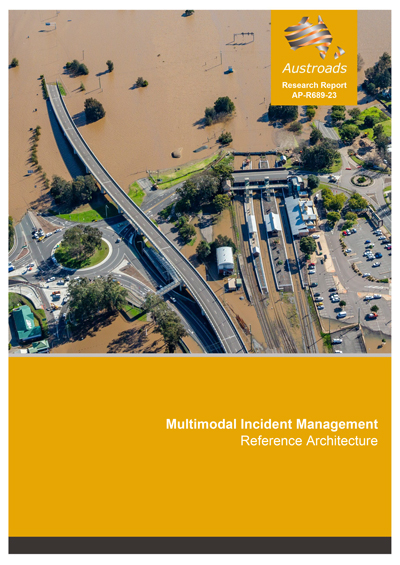Traffic Management

- Publication no: AP-R689-23
- ISBN: 978-1-922700-92-6
- Published: 27 April 2023
- PDF (free) Download
This report presents a set of reference architecture models, content and guidance for use by road agencies to identify, plan and improve their Multimodal Incident Management (MMIM) capabilities.
MMIM is defined as the resolution of an unplanned incident that negatively impacts, or has the potential to impact, the normal operation of more than one transport mode. MMIM aims to maintain transport services and minimise journey disruptions in day-to-day transport operations. It involves a coordinated response from multiple road and public transport operators to resolve incidents and restore the transport network to normal operating conditions.
The reference architectures describe two high-priority topic areas identified by Austroads members: Situational Awareness Tool (SAT) and a MMIM system, which are closely related. A SAT is an information system that provides road and public transport network monitoring and incident detection. A MMIM system is an information system that supports the management and resolution of detected incidents with its operational partners across the road and public transport network. Both systems are defined using a series of outputs that describe the required business architecture and information system aspects of each topic. Agencies are expected to adopt and adapt the architectures to suit their existing environments.
This report also contains guidance for agencies on how to use the MMIM Reference Architecture in the context of planning and delivering MMIM capability improvements. This guidance contains instructions on how the MMIM Capability Maturity Model can be used to achieve target states and improve agency MMIM.
Watch a webinar with David Yee and Andrew Somers for a detailed overview of the report.
- Summary
- 1. Introduction
- 1.1 Purpose
- 1.2 Scope
- 1.3 Methodology
- 2. MMIM Context within Road and Public Transport Operations
- 3. Relationship between a SAT and MMIM System
- 4. Situational Awareness Tool Reference Conceptual Architecture
- 4.1 SAT Reference Architecture Capability Scope
- 4.1.1 Network Monitoring and Incident Detection Capability Levels
- 4.2 SAT Business Architecture
- 4.2.1 Network Monitoring and Incident Detection Goals, Objectives and Needs
- 4.2.2 Network Monitoring and Incident Detection Context within MMIM Decision Making Process
- 4.2.3 Network Monitoring and Incident Detection Value Streams
- 4.2.4 Actors Involved in Network Monitoring and Incident Detection
- 4.2.5 Situational Awareness Tool User Roles and Responsibilities
- 4.3 Situational Awareness Tool Information Systems Architecture
- 4.3.1 Situational Awareness Tool Context
- 4.3.2 Situational Awareness Tool Application Components
- 4.3.3 Situational Awareness Tool Data Flows
- 4.3.4 Situational Awareness Tool Data and Information Needs
- 4.1 SAT Reference Architecture Capability Scope
- 5. Multimodal Incident Management System Reference Conceptual Architecture
- 5.1 MMIM System Reference Architecture Capability Scope
- 5.2 MMIM System Business Architecture
- 5.2.1 MMIM Phases, Goals and Objectives
- 5.2.2 Actors Involved in MMIM
- 5.2.3 MMIM System User Roles and Responsibilities
- 5.2.4 MMIM System Use Cases
- 5.2.5 MMIM Value Stream
- 5.2.6 MMIM Activities
- 5.2.7 MMIM Capabilities Required by MMIM Activities
- 5.2.8 High-Level MMIM Information Needs
- 6. MMIM System Information Systems Architecture
- 6.1 MMIM System Context within a Jurisdiction
- 6.2 MMIM System Context within an Agency
- 6.3 MMIM System Application Components
- 6.3.1 Incident Response Planner
- 6.3.2 Situational Awareness Tool
- 6.3.3 Incident Response Manager
- 6.3.4 Transport Network Manager
- 6.3.5 Operational Communications Manager
- 6.3.6 Travel Demand Manager
- 6.3.7 Communications Gateway
- 6.3.8 Business Intelligence and Analytics Manager
- 6.3.9 Configuration and Administration Manager
- 6.4 MMIM System Communications Diagram and Interfaces
- 6.5 MMIM System Data
- 6.6 Data Required by Use Case
- 7. MMIM Capability Target States
- 7.1 MMIM Capability Targets
- 7.1.1 Phase: Plan
- 7.1.2 Phase: Monitor and Detect
- 7.1.3 Phase: Respond
- 7.1.4 Phase: Restore
- 7.1.5 Phase: Review
- 7.2 Information Systems Target States
- 7.1 MMIM Capability Targets
- 8. Guidance on How to Use the MMIM Reference Architecture to Improve MMIM Capability
- 8.1 Determine Current State MMIM Capability
- 8.2 Determine Target State MMIM Capability
- 8.3 Gap Analysis
- 8.3.1 Prioritise Improvements
- 8.4 Develop the Roadmap
- 8.5 Plan and Deliver Changes
- References
